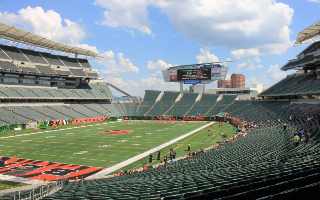Paycor Stadium
| Capacity | 65 000 |
|---|---|
| Country | United States of America |
| City | Cincinnati |
| Clubs | Cincinnati Bengals |
| Category | Design awaiting implementation |
| Cost | $470 M |
| Construction | ? |
| Design | MSA Design |
Advertisement
Paycor Stadium – design description
What does the Paycor Stadium renovation project look like in brief?
The lease for Paycor Stadium, which opened in 2000 and is home to the Cincinnati Bengals (NFL), was set to expire in 2026. As a result, the team began discussions with the owner of the facility – Hamilton County – regarding its future use.
The negotiated agreement extends the lease until 2036, with an option for an additional 10 years. The “package” also includes funding for the largest renovation in the stadium’s history – the county will contribute $350 million, while the Bengals will add another $120 million.
Negotiations over the renovation had been ongoing for some time, and detailed plans were developed in 2024. The project calls for a reconstruction of the stands behind the end zones, with the most significant changes planned for the north stand, which will feature a new, much larger video board, a glass-enclosed VIP area, and an expansive terrace.
Smaller modifications will also affect the sidelines stands, while the stadium’s facade will be complemented with three large screens. The plan also includes a comprehensive redevelopment of the surroundings, including a new square in front of the north stand.
The total cost of all planned works was initially estimated at $1.25 billion; however, only $470 million was ultimately secured. As a result, significant cuts to the project are expected – the Bengals’ training facility and headquarters, for example, are almost certain not to be built.
What is Paycor Stadium like?
The current Cincinnati Bengals stadium was built between 1998 and 2000. Prior to that, the Bengals played at Riverfront Stadium – a multipurpose, circular facility also shared with the Cincinnati Reds baseball team (MLB).
At the end of the 20th century, it was decided to build two separate stadiums next to Riverfront Stadium, one for each team. This also led to the construction of the Great American Ball Park for baseball, while the old stadium was subsequently demolished.
Both stadiums were financed by Hamilton County through a half-percent sales tax increase. The new Bengals facility was originally named after the team’s founder – Paul Brown Stadium. After securing a naming rights sponsor, it was renamed Paycor Stadium in 2022. It is also commonly referred to as “The Jungle”.
The stadium seats over 65,000 spectators and is located in downtown Cincinnati on the Ohio River waterfront. The facility is distinguished by its dynamic, striking design and has won several prestigious architectural awards.
How was the Paycor Stadium renovation project developed?
The initial lease for the stadium was set to expire at the end of June 2026. Several years before that date, the Bengals began discussions with the county regarding the facility’s future.
Together, the team and the authorities commissioned a report, which was completed in 2022. Prepared by the firm Gensler, it concluded that nearly half a billion dollars would be needed for additional renovations and maintenance over the next 20 years – compared with the estimated $1–2 billion cost of building a new stadium.
Remaining at the existing stadium was the best option for the Bengals – the facility was still relatively new and had been properly maintained with the support of local authorities.
Although ideas about building a new stadium or even relocating the team to another city appeared in the public sphere, they were not seriously considered. The Bengals were primarily focused on a renovation that would make the stadium more modern and better suited to the needs of the team and its fans.
The renovation plans for Paycor Stadium were developed in 2024 by the local studio MSA Design, commissioned by Hamilton County. The project was made public in September 2024, with an implementation cost estimated at $1.25 billion.
In the fall of 2024, the possibility of fully roofing the stadium was also analyzed. The cost of such an undertaking was estimated at $900 million to $1 billion, but the authorities ultimately deemed it too expensive.
What does the Paycor Stadium renovation project include?
One of the main elements of the Paycor Stadium renovation is the expansion of the north end zone stand. New seating sections and a large VIP pavilion (the North Endzone Club) will be added at its upper level.
At the top of this stand, a wide terrace with access to food and beverage outlets is planned, along with a special platform designed for the distinctive pregame ceremony – the Ruler of the Jungle. Above the terrace, a new, massive video board measuring 200 by 60 feet will be installed.
To a lesser extent, the south stand will also be renovated, featuring a modest second tier and a so-called Party Deck, while the adjacent building will be topped with a “green” roof.
The changes will also affect the stands along the field, where new premium areas and a so-called Hall of Champions will be created. Their external facades will feature two large screens, while a third external screen will be installed on the northern facade.
The Paycor Stadium renovation will be by far the largest investment carried out since the stadium opened. However, the project does not include radical changes that would significantly alter the character of the facility. The stadium’s capacity is also expected to remain roughly the same as before the renovation (around 65,000 spectators).
What changes are planned for the area around Paycor Stadium?
Significant changes are also planned for the area surrounding the stadium. A plaza with the team’s official store will be built in front of the north stand (North Plaza), extending further along the east and west stands.
Mehring Way, which currently runs along the south side, will be slightly relocated closer to the river, and a landscaped promenade (Bengals Promenade) will be created along it. The section of Central Avenue adjacent to the stadium will be transformed into another pedestrian walkway (Paul Brown Way).
The spatial reorganization also involves the removal of an existing cement factory located on the site.
The largest investment in the stadium’s surroundings will be the construction of a new training complex, including the Bengals’ headquarters. The plan calls for two new fields, one of which will feature a covered stand for 2,000 spectators and will also serve the local community.
Next to the outdoor fields, a large 400,000-square-foot building will be constructed. It will house a third full-size field, an expanded training area, and the new Bengals headquarters, which will relocate the team’s offices from the stadium itself.
Further west, on the site of the former indoor field (covered by an air-supported dome), new landscaped parking lots are planned, which will also accommodate tailgating activities.
When will the Paycor Stadium renovation take place?
In April 2025, the county presented an updated plan, under which the renovation was expected to be less expensive ($830 million), with work scheduled for 2026–2028. In a memorandum signed shortly afterward, the timeline was set for 2026–2029.
The county sought $350 million in funding from the state of Ohio, which had previously contributed $600 million to support the construction of a new stadium for the Cleveland Browns. However, in the case of Paycor Stadium, state authorities were not willing to contribute to the renovation.
Without state support, the project was scaled down to $470 million, with $350 million provided by Hamilton County and $120 million from the Bengals. A preliminary agreement between the county and the team was reached in early July 2025.
On July 31, 2025, the Hamilton County commissioners approved an agreement with the Bengals, which included not only funding for the stadium renovation but also a new lease set to run through June 2036, with an option to extend it for an additional 10 years. On August 1, official statements announcing the agreement were released.
What changes might occur in the Paycor Stadium renovation plans?
The project presented in September 2024 called for substantial investment of $1.25 billion. When the updated plan was presented in April 2025, the figure was reduced to $830 million, and the construction of a new training complex and team headquarters adjacent to the stadium was no longer mentioned.
After the further significant reduction of the budget to $470 million, additional cuts to the project are likely to be unavoidable.
At the end of August 2025, the Bengals announced plans to renovate the premium areas at the stadium. The work is scheduled for 2026 as part of the extensive modernization of Paycor Stadium.
Advertisement
Renderings
-

2024 © MSA Design 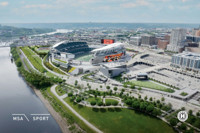
2024 © MSA Design 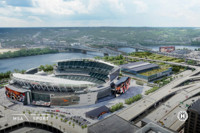
2024 © MSA Design 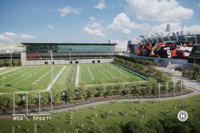
2024 © MSA Design 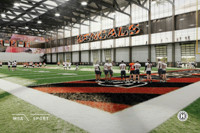
2024 © MSA Design 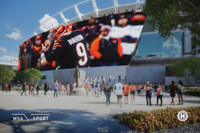
2024 © MSA Design 
2024 © MSA Design 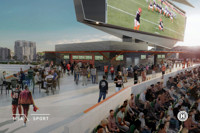
2024 © MSA Design 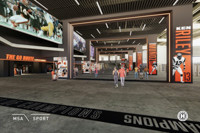
2024 © MSA Design 
2024 © MSA Design 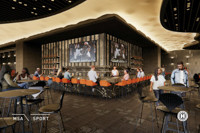
2024 © MSA Design

 StadiumDB
StadiumDB